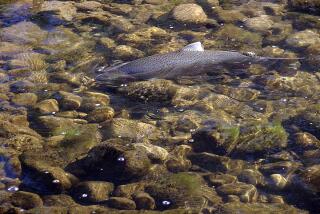U.S. proposes downlisting arroyo toad from endangered to threatened
A 20-year struggle by conservationists to secure maximum protection for the arroyo toad appears to be far from over, as the U.S. Fish and Wildlife Service this week announced that the stout-bodied, short-legged amphibian is ready to hop off the endangered species list.
The agency proposed downlisting the toad from endangered to threatened after determining that conservation efforts had improved habitat and reduced threats over the last two decades in areas including the Marine Corps Base Camp Pendleton in San Diego County.
When Anaxyrus californicus -- a 3-inch, buff-colored amphibian with dark spots and warts -- was listed under the federal Endangered Species Act in 1994, it had lost more than 75% of its historical habitat to development, mining, agriculture and predation by non-native species.
At the time, 22 river basins in the United States supported varying numbers of the toads. Today, the toad is found in 25 river basins, Fish and Wildlife Director Dan Ashe said.
“This demonstrates once again how the Endangered Species Act can work to pull plants and animals back from the brink of extinction,” he said.
Environmental organizations scoff at the agency’s logic, pointing out that its own recovery plan criteria for downlisting the species have not been met and that threats remain.
“It’s clearly premature to lower the arroyo toad’s status,” said Collette Adkins Giese, an attorney and biologist with the Center for Biological Diversity.
In its proposal to downlist the species, Fish and Wildlife concedes that “we do not have statistically valid trend data of arroyo toad occurrences that would allow us to project whether populations are declining, stable or increasing as described in the Recovery Plan.”
Instead, the agency said it had decided to “consider, based on the best scientific and commercial data, whether available information indicates arroyo toads are self-sustaining.”
It concluded that comprehensive land management plans such as those in all four national forests in Southern California – Angeles, Cleveland, San Bernardino and Los Padres – coupled with the continued existence of toad populations identified at the time of listing mean that “we have met the overall intent of the downlisting criteria” for the species.
Adkins Giese disagrees. “From our perspective, the downlisting criteria are based on science and should not be ignored,” she said. “The Endangered Species Act is doing its job – but there’s more work to be done on this toad.”
The Endangered Species Act requires the federal government to designate critical habitat for endangered and threatened species, creating an additional level of review for building and land-use permits.
But even with creature comforts provided by critical habitat – shallow water, sandy banks and willows and buckwheat buzzing with insects to feed on – the arroyo toad faces threats such as fungal infections, climate change and predation by raccoons and bullfrogs.
Today, the arroyo toad persists in 22 small, isolated populations, mostly in the headwaters of coastal streams along the central and southern coasts of California and southward to Baja California.







